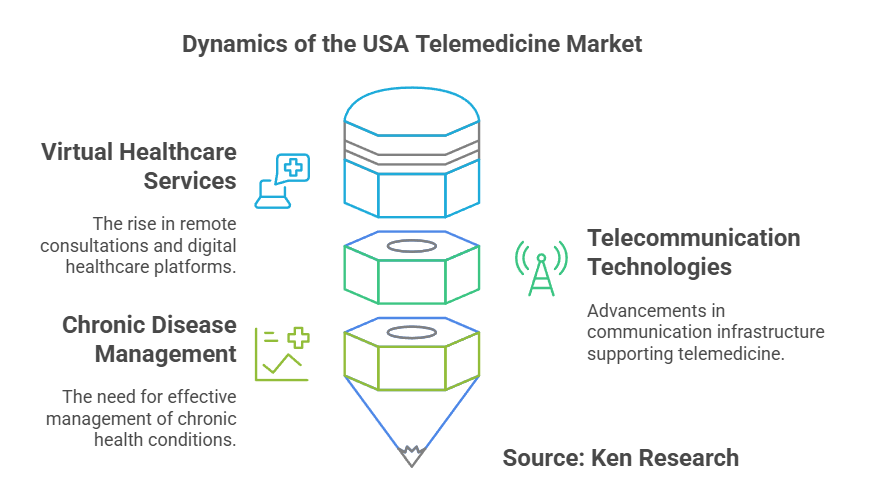Top Emerging Opportunities in the USA Telemedicine Market in 2028

Strong 8k brings an ultra-HD IPTV experience to your living room and your pocket.
The USA telemedicine market is experiencing rapid growth, driven by the increasing adoption of virtual healthcare services, advancements in telecommunication technologies, and the urgent need for chronic disease management. Valued at USD 30 billion, this sector is becoming an integral part of the modern healthcare system.
As telemedicine gains traction, new business opportunities are emerging, offering significant potential for investors, startups, and healthcare providers. Whether it's specialized telehealth services, AI-driven diagnostics, or rural healthcare expansion, the sector presents multiple untapped avenues. In this article, we will explore key emerging opportunities, the barriers to entry, and actionable strategies for businesses looking to thrive in this dynamic industry.
Current Market Status
The USA telemedicine market has grown substantially in the past five years, reaching a valuation of USD 30 billion. This expansion is fueled by several factors:
- Technological Advancements: High-speed internet, 5G connectivity, AI-driven diagnostics, and wearable health tech are improving remote patient monitoring.
- Regulatory Support: The U.S. government and healthcare regulators have eased restrictions on telehealth reimbursement, encouraging its adoption.
- Rising Consumer Demand: Patients prefer the convenience and accessibility of virtual consultations, especially post-pandemic.
- Chronic Disease Management: The growing prevalence of conditions like diabetes, hypertension, and cardiovascular diseases has increased demand for remote patient care.
- Key Players in the Market: Companies like Teladoc Health, MDLIVE, Amwell, and Doctor on Demand dominate the industry by offering a variety of telehealth solutions.
With these factors driving growth, let's explore the most promising emerging opportunities in the telemedicine sector.
Emerging Opportunities in the USA Telemedicine Market
1. Expansion into Rural and Underserved Areas
- Opportunity: A significant portion of the U.S. population, particularly in rural regions, lacks access to quality healthcare.
- Supporting Data: Studies show that one in five Americans lives in a rural area with limited access to healthcare professionals.
- Future Potential: Telemedicine providers can expand into these underserved regions using mobile health clinics, remote patient monitoring, and AI-driven diagnostics.
2. Specialized Telehealth Services (Mental Health, Dermatology, and Women’s Health)
- Opportunity: Telehealth is moving beyond general consultations into specialized fields like mental health therapy, dermatology, and women’s health.
- Supporting Data: The demand for virtual mental health services increased by over 40% post-pandemic.
- Future Potential: Companies offering personalized, specialty-driven telehealth solutions can establish a strong niche.
3. AI and Machine Learning Integration in Telemedicine
- Opportunity: AI-powered chatbots, virtual health assistants, and automated diagnostics are enhancing telemedicine efficiency.
- Supporting Data: The AI healthcare market is projected to exceed USD 45 billion globally by 2026.
- Future Potential: Businesses that integrate AI for faster diagnosis, predictive analytics, and automated patient monitoring will gain a competitive edge.
4. Corporate and Workplace Telemedicine Solutions
- Opportunity: Employers are integrating telehealth into their employee wellness programs to reduce absenteeism and healthcare costs.
- Supporting Data: Over 60% of U.S. employers now offer virtual healthcare options as part of employee benefits.
- Future Potential: Telemedicine providers can partner with corporations to develop customized employee health solutions.
5. Wearable Technology and Remote Patient Monitoring
- Opportunity: The demand for smart health wearables is rising, allowing real-time health tracking.
- Supporting Data: The global wearable medical device market is expected to reach USD 60 billion by 2027.
- Future Potential: Telehealth companies can integrate wearable data with remote patient monitoring systems for early disease detection and preventive care.
Also read the market analysis of Indonesia Telemedicine Industry Future Opportunities
Barriers to Entry in the Telemedicine Market
While opportunities in telemedicine are abundant, new businesses must navigate key challenges:
- Regulatory and Compliance Issues: Adhering to HIPAA regulations and state-specific telehealth laws can be complex.
- Reimbursement and Insurance Challenges: Variability in insurance coverage and reimbursement rates can affect profitability.
- Technology Infrastructure Requirements: Setting up a secure, high-speed digital platform requires significant investment.
- Patient Trust and Digital Literacy: Some patients, especially older adults, may lack digital literacy or trust virtual care.
- Data Privacy and Cybersecurity Risks: Ensuring strong cybersecurity measures is crucial to protect patient data.
How to Overcome These Barriers
- Regulatory Compliance: Work with legal experts to ensure compliance with state and federal regulations.
- Insurance Partnerships: Collaborate with insurance companies to create inclusive telehealth plans.
- Tech Investment: Use secure cloud-based platforms and AI-driven solutions to enhance service delivery.
- Patient Education: Conduct awareness campaigns to help patients feel comfortable using telehealth services.
Actionable Insights for Businesses
For companies looking to capitalize on the telemedicine boom, here are some key strategies:
- Invest in AI and Automation: Automating administrative tasks and diagnostics can improve efficiency and reduce costs.
- Form Strategic Partnerships: Collaborate with insurance providers, hospitals, and corporations to expand your reach.
- Focus on Niche Markets: Specializing in mental health, dermatology, or remote chronic disease management can help companies stand out.
- Enhance Cybersecurity Measures: Implement blockchain and advanced encryption to ensure data security.
- Adopt a Patient-Centric Approach: Ensure a user-friendly experience by improving the design and accessibility of telehealth platforms.
Conclusion
The USA telemedicine market presents numerous emerging opportunities, from rural expansion and AI integration to wearable technology and corporate healthcare solutions. Despite regulatory challenges and technological barriers, businesses that adopt innovative strategies, strong cybersecurity, and niche specialization can thrive in this rapidly evolving landscape.
With a USD 30 billion market valuation, the future of telemedicine looks promising, offering lucrative opportunities for startups, healthcare providers, and investors. Now is the time to embrace innovation and shape the future of virtual healthcare.
Read my other blogs in Asia Pacific Paper Packaging Market Trends and Opportunities
Note: IndiBlogHub features both user-submitted and editorial content. We do not verify third-party contributions. Read our Disclaimer and Privacy Policyfor details.







